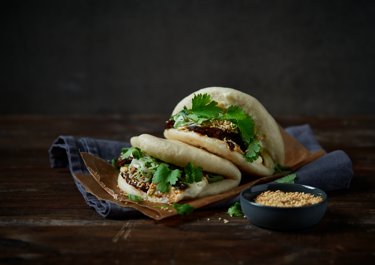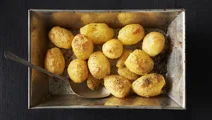
Bao Buns

Instructions
Bao buns
Chili mushroom
Garnish
Bao Buns
The Chinese word bao translates as ‘bun’. The open bao bun is a popular, sandwich-like version of bao, where the (traditionally fermented) dough is steamed before adding the filling. A steamed bun can also be a dumpling-like pillow of dough – filled, closed, and then steamed. Both kinds of bun can be filled with a great variety of ingredients, most often savoury but sometimes sweet. What kind of bun you will be served depends on where you are and who is making it. Either way, you are in for a treat.
While dumplings can be boiled, steamed, or sautéed, bao buns are meant to be steamed. The soft, pillowy, chewy texture of the bao bun can only be achieved through steaming. However, you don’t have to invest in an electric steamer to enjoy bao buns at home. An affordable bamboo steaming basket propped on top of a pot will give perfect results every time. A metal colander with a lid on top can also serve as a steamer.
The flavour in a bao bun comes mainly from its filling, which can be sweet, savoury, spicy, or zingy. The subtle flavour and soft texture of the steamed wheat bun itself is like a canvas, ready to hold whatever flavour you crave.
A steamed bao bun is arguably a complete meal in itself – at least by street food standards. If you want to serve bao buns with a side dish, any kind of Asian salad will be perfect. You can also put dipping sauce and a bowl of freshly boiled edamame beans with sea salt on the table. As for drinks, savoury bao buns go very well with a lager type beer, ice-cold lemonade, or almost any chilled beverage.
You will find different versions of steamed bao buns in Chinese, Korean, and Vietnamese restaurants and street food stands all over the world. The fillings will vary and reflect the different cuisines. However, bao buns are originally a Chinese invention. It’s the versatile nature of the steamed bun that lets various cuisines adopt it and make it its own.
The soft and delicate bao bun is actually very easy to freeze for later use. First, let the steamed bun cool off. Then, line a container with parchment paper to prevent the buns from sticking. Place the buns in the container, leaving room between them so they don’t stick together. Then close, label, and place the box in the freezer. Your buns can stay frozen for up to three months. You can steam the frozen buns without defrosting them first – just add a few minutes of cooking time. Or simply defrost them overnight in the fridge.
Ingredients
Bao buns
|
Yeast
|
25 g |
|---|---|
|
Milk
|
150 ml |
|
Water
|
100 ml |
|
Cooking oil
|
1 tbsp |
|
Caster sugar
|
1 tbsp |
|
Flour
|
360 g |
|
Baking powder
|
½ tsp |
|
Salt
|
2 pinches |
Chili mushroom
|
Portobello mushrooms
|
450 g |
|---|---|
|
Butter
|
2 tbsp |
|
Sriracha sauce
|
2 tbsp |
|
Japanese soy
|
2 tbsp |
|
Liquid honey
|
2 tbsp |
Garnish
|
Spring onion
|
1 |
|---|---|
|
Mayonnaise
|
100 ml |
|
Fresh coriander
|
1 bunch |
|
Roasted sesame seeds
|
2 tbsp |
Bao – fluffy buns with savoury fillings
Steamed bao buns with savoury filling are an irresistible Asian street food. The word bao simply means bun, and bao come with a wide range of shapes and fillings. The open bao is a popular version, often filled with savoury pork, beef, duck, or prawns. Our version is vegetarian, with portobello mushroom and sriracha sauce that lets you turn up the heat as far as you want.
Try these tasty variations of bao buns
Steamed bao buns can be served with an almost infinite number of fillings. For meat lovers, sticky pork belly, pulled BBQ beef, and hoisin duck are perhaps the most popular fillings. Miso-glazed salmon or tempura prawns are the perfect choice for a seafood version. Vegetarian bao can be filled with mushrooms or miso-glazed aubergine. Lettuce, coriander, pickled onions, and a fresh Asian slaw are all perfect complements to the savoury filling. Finally, add extra moisture and flavour with sriracha and mayo, mixed to your preferred level of hotness.
The vegetarian variant
Bao is by no means only for carnivores. Our vegetarian mushroom version is guaranteed to satisfy even the most ardent meat lover. The trick is to sauté the mushroom in butter until it develops a deep flavour and browned surface with soft centre.










